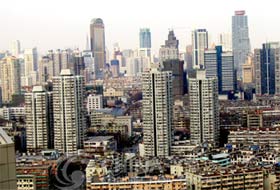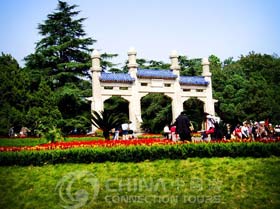
 Nanjing (Nan-ching or Nanking), meaning "southern capital," is now the capital of Jiangsu Province. A vigorous and attractive metropolis, it serves both as a busy port on the Yangtze River and a popular tourist city. Principal industries here include cement, fertilizer, chemicals, electronic equipment, iron and steel, motor vehicles and machine tools. It has become the economic and cultural center of the lower reaches of the Yangtze River.
Nanjing (Nan-ching or Nanking), meaning "southern capital," is now the capital of Jiangsu Province. A vigorous and attractive metropolis, it serves both as a busy port on the Yangtze River and a popular tourist city. Principal industries here include cement, fertilizer, chemicals, electronic equipment, iron and steel, motor vehicles and machine tools. It has become the economic and cultural center of the lower reaches of the Yangtze River.
The entire city spans the Yangtze, taking up 6,516 sq. km (2,504 sq. mi). Nanjing enjoys a warm, damp, sub-tropical climate. The annual average temperature here is 15.3 Co, with an average temperature of 2.5 Co in January and an average temperature of 26.1 Co in July. The highest temperature in Nanjing hits 40 Co, thus making it one of the "three furnaces" in China. The annual rainfall measures 1,106.5 mm, and the middle ten days of July abound in plum rains. Nanjing has rich water resources. Of the whole area, 10 percent is cultivated fields, 30 per cent hills, and the rest covered with water.
Nanjing has a population of 5.2 millions. The main inhabitants are Han nationality. The main religions here are Buddhism and Taoism. The natives speak Shanghai dialect, but the government language is still mandarin.
The history of Nanjing goes back 5,000 to 6,000 years. Originally the city was built in 473 B.C. by Goujian, King of Yue State and was named Yuecheng. Later the Chu State had a city called Jinling erected at the foot of Qingliangshan Hill. Yuecheng and Jinling were the embryonic forms of Nanjing. Until the Three Kingdom Period, Sun Quan, King of Wu state, had his military fortress built here with the giant rocks from the river as the wall and named it the Stone City. Ever since then, Jinling, Shitou (Stone) have been the ancient aliases of Nanjing.
Nanjing saw its prime time from the 3rd to the 6th century when it was the national capital for six dynasties. The city's present name was given by the first Ming emperor, Zhuyuanzhang, who transferred the imperial court to this city in 1356 AD. Many aristocrats, businessmen, and craftsmen thronged to the south, promoting the development of culture, economy, crafts and technology in Nanjing. Nanjing, the biggest city of the time became a new cultural center in ancient China.
 In 1842, British troops and gunboats laid siege to Nanjing in the Opium War, forcing the Qing dynasty to sign the Treaty of Nanjing, imposing upon China the necessity that five ports be opened to free trade. This treaty also marked the beginning of the 1st Opium War. The renowned Taiping Heavenly Kingdom Rebellion started here in 1851, which turned the city into the headquarters of the rebels.
In 1842, British troops and gunboats laid siege to Nanjing in the Opium War, forcing the Qing dynasty to sign the Treaty of Nanjing, imposing upon China the necessity that five ports be opened to free trade. This treaty also marked the beginning of the 1st Opium War. The renowned Taiping Heavenly Kingdom Rebellion started here in 1851, which turned the city into the headquarters of the rebels.
As a result of fierce battles, Nanjing was seriously damaged. In 1911, Nanjing became the capital for the new China Republic for a short period of time and the place where Dr. Sun Yatsen was made the president of the provisional government. From 1927 to 1937, Nanjing served as the capital for the China Republic and later as the KMT government’s capital during the civil war from 1945 to 1949. During WW II, the Japanese invaded the city and massacred 300,000 civilians within a few days. Nanjing suffered the most serious damage in its history. In the April of 1949, the Chinese Liberation Army crossed the Yangtze River and liberated the city.

